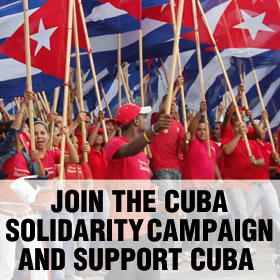Medical brigades have treated 85 million
Campaign News | Friday, 4 April 2008
More than 85 million people have been seen by Cuban medical personnel,
with an estimated 615,000 lives having been saved to date. This
solidarity reaches all continents.
After 45 years of existence, the Cuban Medical Collaboration Program
continues as a model and a cornerstone of the nation’s international
policy, as well as one the highest forms of altruism ever showed to
sister nations.
Currently, more than 36,500 collaborators of the health system,
including professionals and technicians, offer their services in 73
countries in Latin America, Asia and Africa; the number of countries
will rise to 81 in 2008.
Throughout all these years, they have saved an estimated 614,383 lives,
seen 85,099,737 patients, and they have performed 221,712 surgeries.
Such amazing figures show the magnitude of the message of peace, love
and solidarity taken by the Cuban professionals to every corner of the
globe, despite the race, faith or ideology of the patients, fully
respecting the law and customs of the territories where they work.
In the first month of 1959, Fidel Castro outlined the precepts that
would lead us to institute this kind of collaboration as one of the
basic principles governing Cuba’s foreign policies.
The definite step, however, was not taking until 1963, when the first
International Medical Brigade departed for Algeria. The brigade was made
up by 58 professionals who worked in that country for 14 months.
At the time, Algeria had just gained its independence from the French
metropolis; the regime bequeathed the country an impoverished public
health situation.
Although back then Cuba did not have an organized and strong healthcare
system -the country had just emerged from a similar situation- the
country answered to the request for help made by the Algerian government.
SOLIDARITY TAKEN TO THE MOST REMOTE PLACES
That was the beginning of a journey that continues into the present,
saving lives in the most remote and obscure places in the world.
In 1998, after Hurricane Mitch hit many Central American countries -
particularly Honduras y Guatemala- leaving a horrendous trail of death
and missing people, an Integral Healthcare Program (PIS) was organized.
Its benefits extended to almost all the countries in Central America and
the Caribbean.
Cuban doctors also work in immunization campaigns and in prevention
programs against AIDS in areas where they offer their services.
Likewise, in September 2005 the Henry Reeve Internationalist Brigade was
created. The brigade, named after an American volunteer who fought for
independence of Cuba in the 19th century, is formed by doctors specially
trained to work assisting victims of natural disasters and severe
epidemics.
This brigade has accomplished important missions, such as those in
Guatemala after the passing of Hurricane Stan; in Pakistan, after the
powerful earthquake that affected the north of that nation in 2005; in
Bolivia during the disastrous floods they suffered; and more recently in
Peru, after the earthquake that took place in 2007.
BRIGADE SPECIALIZED IN DISASTERS
This brigade originated from an idea of Commander-in-chief Fidel Castro,
who conceived of it to give special attention to the victims of the
Hurricane Katrina, which destroyed the US city of New Orleans. The US
government rejected the free help offered by Cuba, although they didn’t
have the means to address the healthcare service requirements of the
victims.
However, Cuba’s only concern is not temporarily easing the pain of those
in need, the Caribbean country also takes care of developing the
necessary human resources, which greatly benefit these sister nations.
That is the reason why in 1961 Cuban included in its cooperation policy
for education, the granting of scholarships to many students from
underdeveloped nations. This concept materialized in the creation of the
Latin American School of Medicine (ELAM), one of the highest expressions
of the principles of solidarity that form the ethical grounds of the
Cuban medical collaboration program and of a considerable part of the
Integral Healthcare Program.
More than 3,000 students have graduated from that institution, and
another 10,000 from 28 nations are currently studying there.
Worth mentioning also is Operation Milagro, a Cuban-Venezuelan project
aimed at healing curable ophthalmic diseases.
This one-of-a-kind program started in the Bolivarian Republic of
Venezuela in 2004 with the objective of restoring the eyesight of six
million Latin Americans. By early 2008, the program had already
benefited one million people, and the number of centers for
ophthalmologic surgery donated by Cuba to these country rose to 37.
Cuba’s achievements in the health sector are renowned around the world.
For example, its high levels of life expectancy (at 77 years of age),
and its low rates of infant mortality (5.3 for every thousand live
births) are accomplishments that compare favourably with those of
developed countries like the United States.
In addition, there is a wide variety of health programs designed to
protect citizens, especially children. The latter, for instance, enjoy
an immunization program whose quality equals those of the most developed
countries of the world and has been praised by the World Health
Organization.
On May 28 began the most recent vaccination campaign against
poliomyelitis, one of the diseases eliminated in Cuba after 1959. This
time nearly 500,000 children will be immunized.
There is also one doctor for every 158 inhabitants, a figure typical of
highly industrialized nations.






